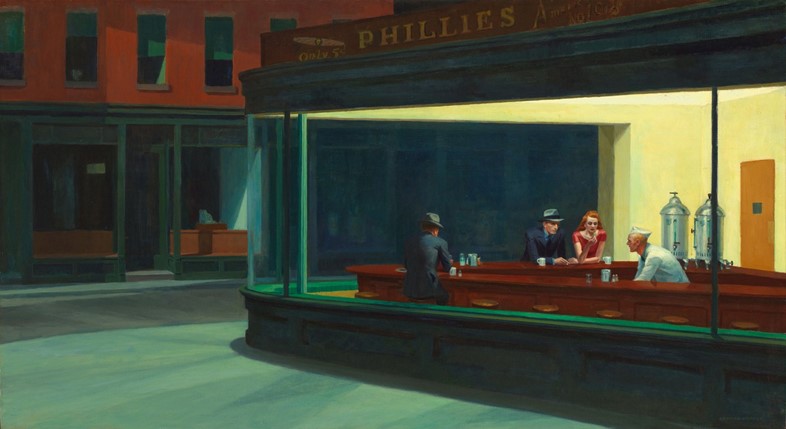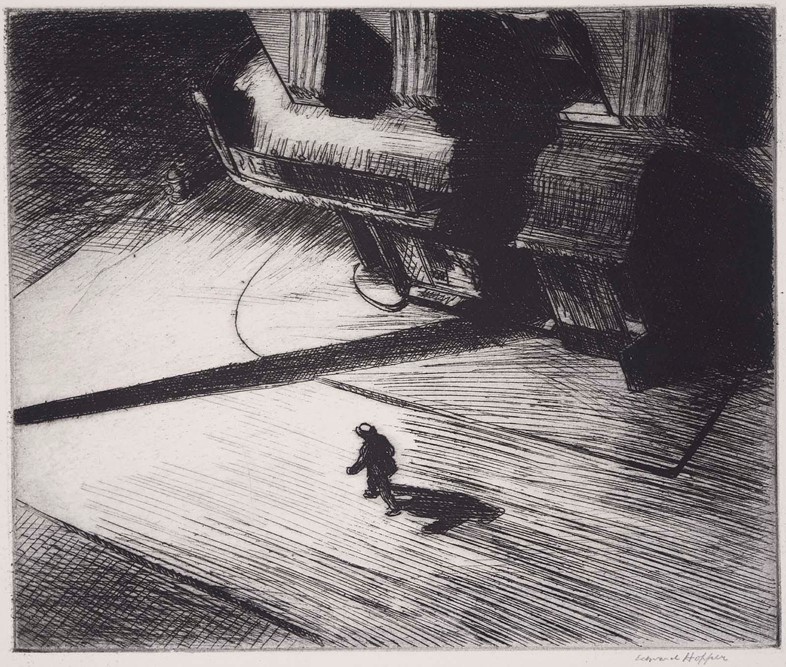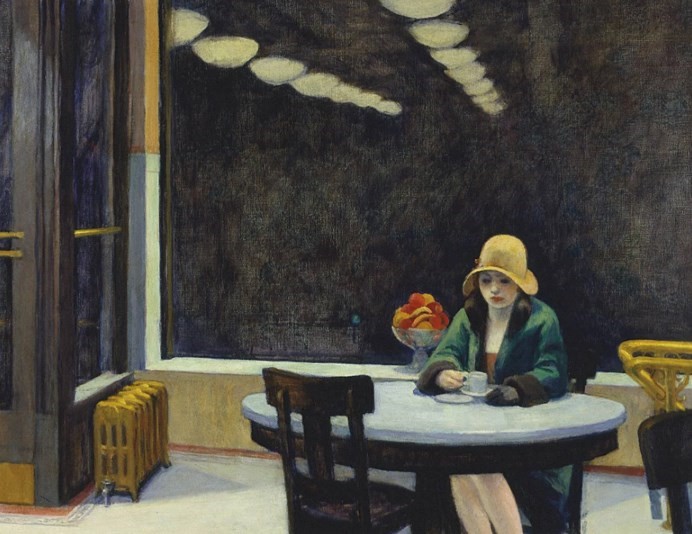The 20th-century American artist – known for his scenes of derelict urban life and social alienation – is going viral
In her book The Lonely City, writer Olivia Laing recounted her brief stint living alone in New York. To her surprise, she found herself surrounded by more people than ever before, yet far more lonely.
She began to ask larger life questions; the frightening existential ones we try to not dwell on when scrolling mindlessly through social media or memes of cute cats. Like, what does it mean to be lonely?
The person who visualised the acute alienation she felt was the American realist painter Edward Hopper – despite the fact that he died over half a century ago and lived in an entirely different era of history.
we are all edward hopper paintings now pic.twitter.com/gpcmSiavkD
— Michael Tisserand (@m_tisserand) March 16, 2020
In 2020, it’s not just Laing identifying with the paintings of Hopper. In the past week, the artist has experienced an overwhelming resurgence of interest. His lonely vision of interwar and post-war America has been liked and shared thousands of times by Twitter and Instagram users.
Hopper’s recent surge in popularity reflects our current predicament. While we wait for this unwelcome guest “coronavirus” to leave our home, we’ve noticed that the world looks uncannily similar to his trademark paintings, for example, “Automat” (1927), “Nighthawk” (1942), or “Morning Sun” (1952).
His psychological paintings created between the 1920s and 1950s pulsate and vibrate with unease, and embody the artist’s view that: “a nation’s art is greatest when it most reflects the character of its people.”
Hopper tapped into the collective consciousness of his time, but inadvertently, he also captured the spirit of 2020 amid a global pandemic, despite the fact that he had once commented: “the loneliness thing is overdone.”
Nevertheless, his depictions of atomized modern life can help us find the silver linings of isolation. Here’s what we can learn from Hopper during this, incredibly bizarre, quarantine culture.
SOCIAL DISTANCING IN SOLIDARITY
Only a few days ago, many of us were living and working in a fast-paced, frenetic world characterised by too much caffeine, endless opportunities, and congested, incredibly unhygienic, commuter travelling (I will never mock people who obsessively use anti-bac again).
Today, many of us might be alone, working from our beds, wishing we invested in more than one pair of comfy pyjamas. Quite literally, life is starting to bear resemblance to this solitary interior seen in Hopper’s Morning Sun (1952), a painting of his wife Jo, which he completed at the age of 70.
Bathed in golden light, Jo appears cut-off from the outside world. But like the rest of Hopper’s figures, she is self-possessing and resigned to her own alienation in an intimidatingly large metropolis, one which, by comparison, makes her an inconsequential human being.
Hopper’s paintings have a candid photographic quality; he had a unique ability for capturing his sitters in a moment of private reverie. Or as one 21st-century Instagram user @alexandraroach1, wrote: “This could be me in the painting, but I would add a phone into her hand…”
Right now, we are constantly reminded of our own insignificance when bombarded with statistical analysis and “big data” on populations, translating human lives (or deaths) into numerical figures.
Like Jo, we feel like trapped, small fish in a global pandemic, at the mercy of nature, of which we have absolutely no control.
But on the other hand, this painting is incredibly comforting. The more often it is shared on social media, the more quickly we remember that everyone else is in the same boat. Or in a similar room, somewhere in the UK, scrolling anxiously through their feed, or pondering the future of human existence.

MODERN LIFE WAS LONELY BEFORE
Let’s be totally honest, loneliness is an unavoidable characteristic of contemporary life, especially when individuals live in large cities.
This is why we all have intense addictions to social media – a virtual façade to mask the underlying angst and another way to find social connection with strangers making witty one-liners on Twitter.
Unabashed loneliness and foreboding are palpable in Hopper’s paintings, explaining why his works have been appreciated worldwide and why he had commercial success during his lifetime.
Hopper, like many others, romanticized the concept of loneliness. As the writer Joyce Carol Oates once said, “Nighthawks” (1942) is “our most poignant, ceaselessly replicated romantic image of American loneliness.”
Fast forward nearly eight decades, users on Twitter believe this image below is an accurate depiction of “Nighthawks” in the age of coronavirus.
Devoid of both human life and romance, it confirms that life in March 2020 is bleaker than life in the midst of World War II in America.
FML.
Nighthawks in the Age of Coronavirus #EdwardHopperpic.twitter.com/r24zFnQcPK
— Nat Moss (@natmoss) March 15, 2020
LET’S ENJOY THE STILLNESS
Another reason why Hopper is a celebrated artist is that his work embodies tranquillity, quiet and stillness. A known depressive for most of his life, his works speak to the inner-worlds of many people who might be struggling with mental health issues, a particularly pertinent issue during this crisis.
A close friend of Hopper, illustrated Walter Tittle, once remarked that he was "suffering...from long periods of unconquerable inertia, sitting for days at a time before his easel in helpless unhappiness, unable to raise a hand to break the spell." Another friend, the fellow painter, Guy Pène du Bois commented: “I’d like to see him out of his present condition. I’d like to see him happy.”
A reflection of his inner world, Hopper’s works are so unsettling at times that they create a sense of trepidation and suspense. For that reason, he inspired countless film directors and photographers, from Alfred Hitchcock to William Eggleston and David Lynch.
But on the question of stillness, we should count our blessings for a moment.
While living in an age very recently defined by ‘burn out’ culture, which the WHO claimed last year would create a “global pandemic”, we have ironically been forced to calm the fuck down and sit still for a minute by some very aggressive and insidious microbes.
Coincidentally, our period of history is beginning to echo the turbulent time that Hopper lived through: the 1918 Spanish flu, the electric energy of 1920s culture, and the sharp economic decline brought on by the Great Depression of the 1930s, as well as two World Wars.
Hopper lived in a frightening and uncertain world, one which compelled him to paint isolated figures in settings of calm disquiet.
Whereas a month ago, we were arguing for “minimalism” over materialism, and “slow fashion” over fast fashion, now we are restlessly awaiting the moment we can return to our fast-paced unsustainable, capitalist consumer-driven lives – the ones that had originally been contributing towards global warming and triggering a mental health crisis.
If Hopper can teach us anything, it is this: although we feel useless sitting at home, unable to control the external pandemonium around us, for now, the best we can do is stay away from others, remember to wash our hands (goddamit), and find ease in our own interior worlds.





